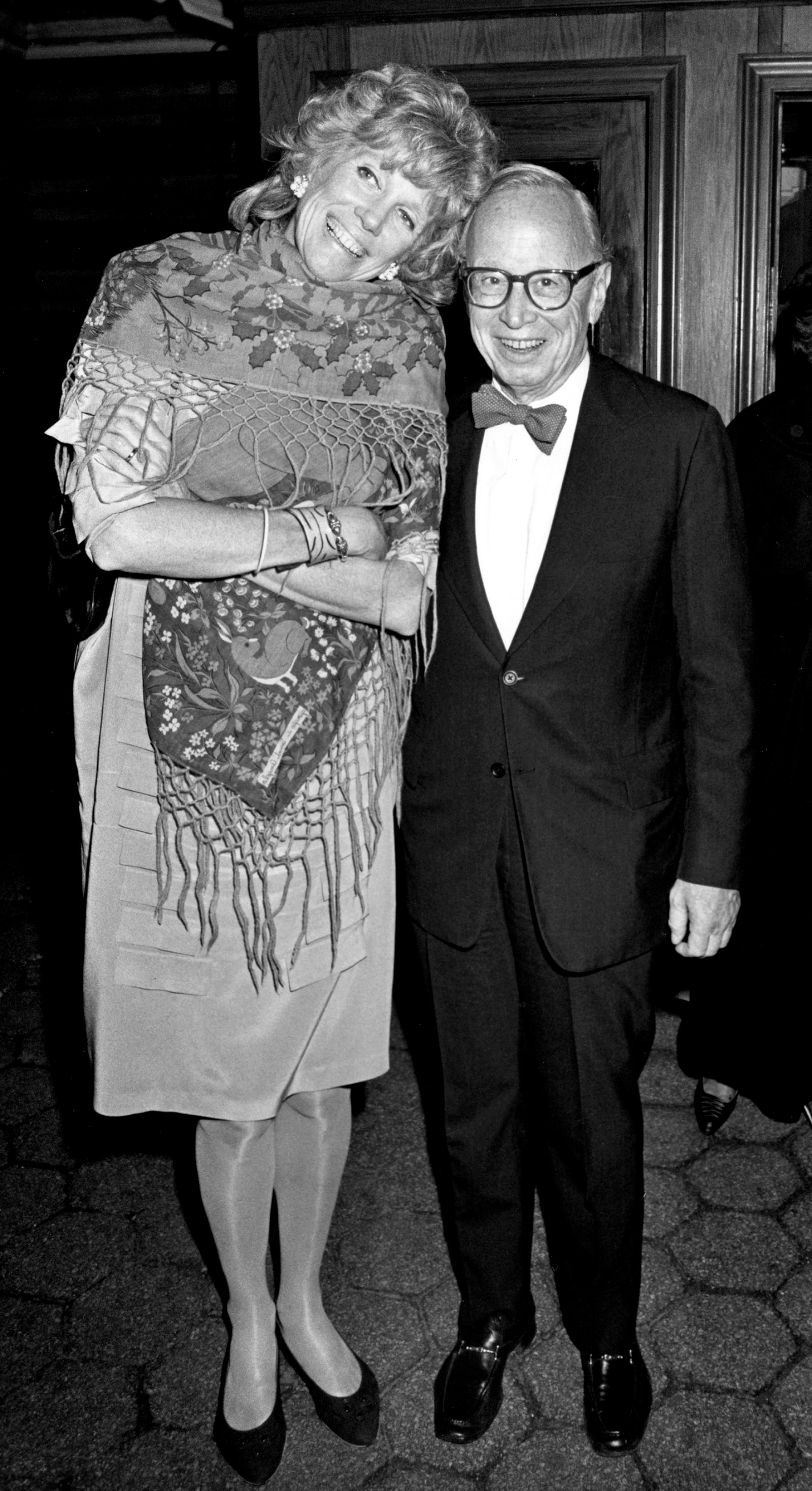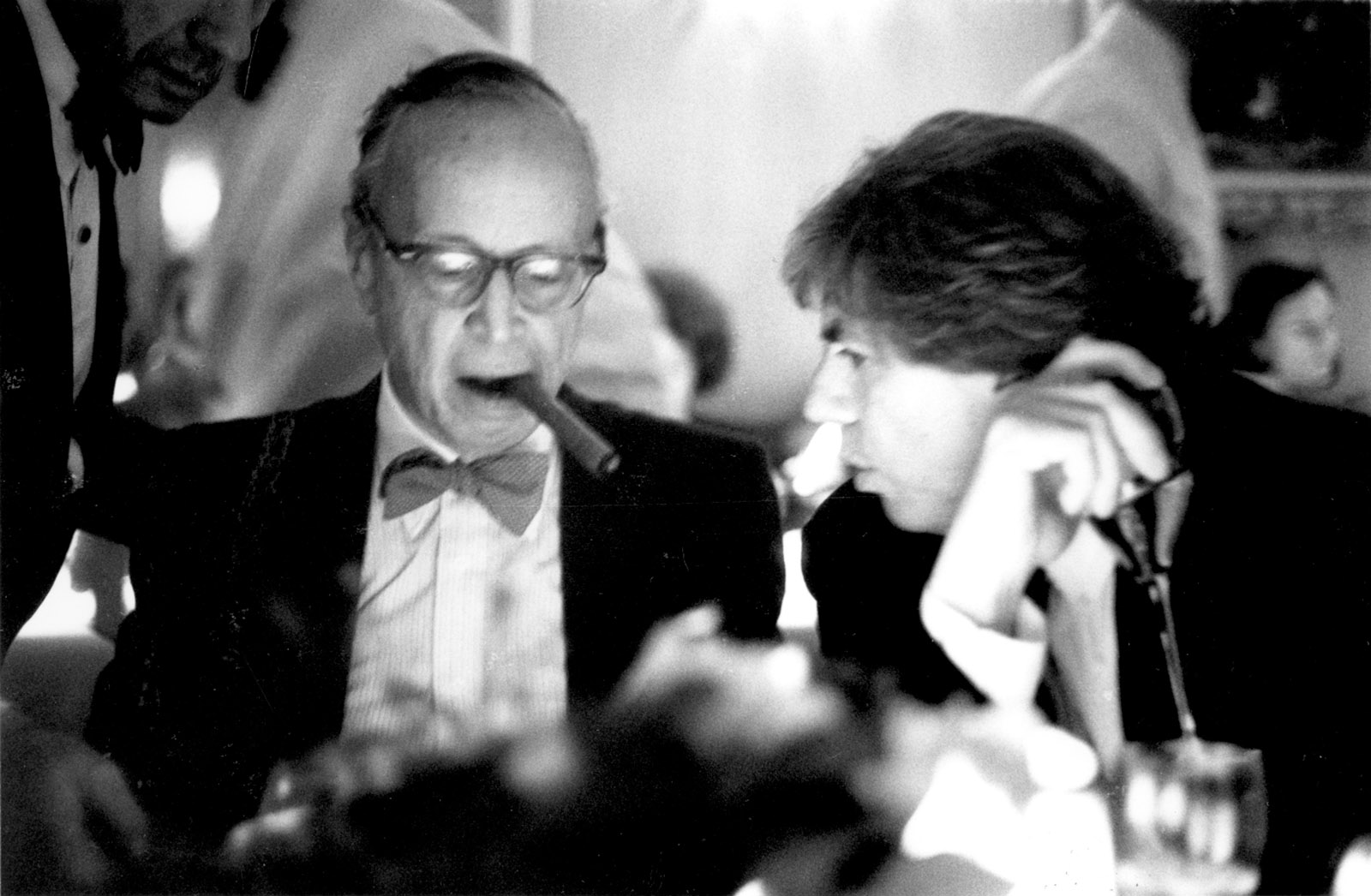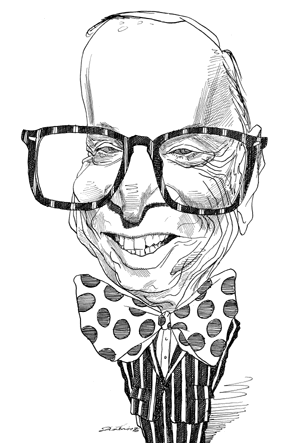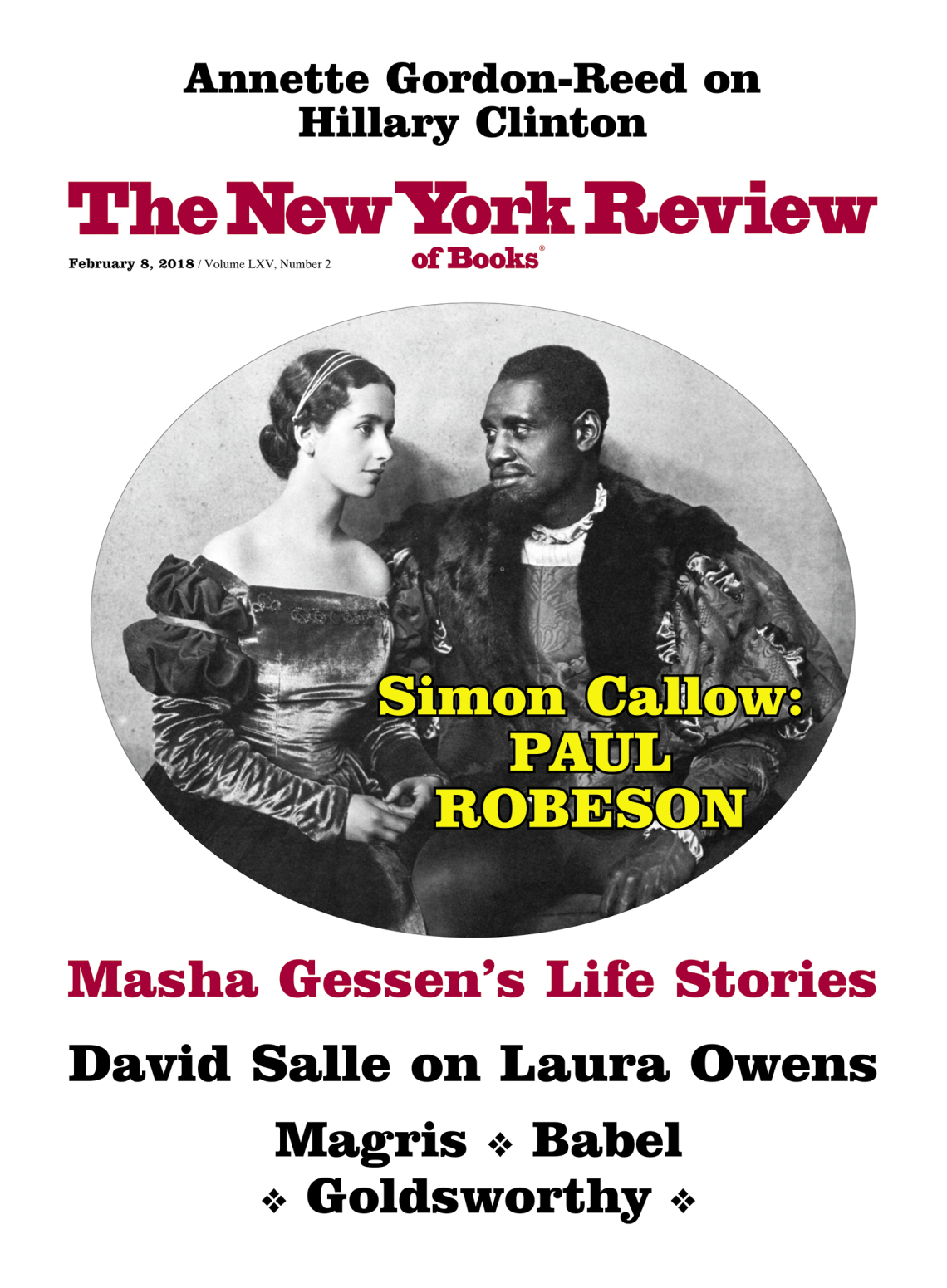Arthur Schlesinger Jr. loved American politics. Nominating conventions thrilled him. Late-night schmoozing on the campaign trail was hard to beat. “I must say,” he wrote in his journal in 1960, “that I adore sitting around hotel rooms with politicians and newspapermen exchanging gossip over drinks.” Some of the precincts he frequented were seriously glamorous. (Also from his journal, about a giant Adlai Stevenson rally at the old Madison Square Garden in 1952: “Lauren Bacall hailed me excitedly…her voice quivering with feeling, ‘Arthur, did you read Walter Lippmann’s column this morning?’”) But Schlesinger delighted in the humblest political rites—whistle-stop speeches at the crack of dawn, hack-filled Democratic Jefferson-Jackson Day dinners—with what he called their mixture of “corny pontifical introductions, wisecracks and seriousness.”
Today the midcentury American liberalism that Schlesinger defended and in large measure defined seems as antiquated as whistle-stops and Jefferson-Jackson Day dinners. About thirty years ago, most liberal politicians and intellectuals (though not Schlesinger) dropped the toxic “L-word,” denigrated by the left as well as the right, and began calling themselves “progressives,” which had been a decidedly antiliberal term of the left. With fewer people rising to claim or even describe its principles, and with the Democratic Party reduced to a congeries of special interests, liberalism lost its élan and came to be redefined by its political enemies.
Now, a decade after his death, Schlesinger’s liberalism, in a remarkable convergence of radical left and radical right, is widely regarded as the politics of a decadent, self-enraptured, war-mongering globalist establishment that long ago abandoned the working class and the poor. Known in left-wing circles as “neoliberalism”—once a precise term in economic theory defining Thatcherism that has morphed into a sweeping pejorative against liberals, progressives, and European social democrats not of the hard left—this caricature stoked rage at both ends of the spectrum in last year’s election and had a lot to do with the victory of Donald J. Trump.
In view of this recent history, the subtitle of Richard Aldous’s otherwise solid biography is misleading as well as erroneous. Arthur Schlesinger Jr. was in no way an “imperial” historian; he was an anti-imperial historian. He created no empire of academic acolytes. Nor did he write of the United States as an empire. He did title one of his finest books The Imperial Presidency, but this was a warning about the dangers of unchecked executive power. Aldous might have better described him as a democratic historian (or even, given his partisan loyalty, a Democratic historian), although that would have elided his elite associations and his old-school, martini-at-lunch, Century Club style. Schlesinger is best described as a liberal historian; he was a leading member of an outstanding generation of liberal historians that included Richard Hofstadter and C. Vann Woodward. Aldous’s subtitle conveys a different impression, portending a book that will string together all the familiar and trite putdowns of Schlesinger as the Kennedy family’s obsequious courtier and (as many leftists saw him) an apologist for various cold war crimes—that is, an imperial historian.
But Aldous, a British-born historian who now teaches at Bard, is not that kind of biographer. His earlier writings on modern Anglo-American diplomacy and, above all, on the sometimes strained relations between Margaret Thatcher and Ronald Reagan shrewdly depict the play of principle, obligation, and psychology that drives politics at the highest levels. It is a quality of perception that distinguished Schlesinger’s best historical writing, and it helps Aldous illuminate that writing as well as Schlesinger’s political forays. Aldous clearly respects Schlesinger’s politics, but his detachment gives him room to criticize without sanctimony and to empathize without evasion. His book helps reveal why Schlesinger mattered so much to the history of modern American liberalism, a history and a politics now badly in need of rescue and repair.
Schlesinger made large intellectual contributions to three major phases of twentieth-century American history: the New Deal, the coming of the cold war, and the advent of the Kennedy and Johnson administrations. Born in 1917, he was too young to be an actual New Dealer; his real influence began in 1945, just after FDR’s death, when (fresh from the Harvard Society of Fellows via the Office of Wartime Information and the Office of Strategic Services, and not yet thirty) he published his second book, The Age of Jackson. For decades, patrician historians had defamed Andrew Jackson’s presidency as an erratic disaster, headed by a lawless, violent, unschooled ruffian and supported blindly by the newly enfranchised, ignorant masses. Schlesinger replaced that view with an account of Jackson as a genuine democratic leader, the foe of monopoly and what his supporters called “the money power” as well as of the militant, fractious South Carolina slaveholders led by John C. Calhoun. Above all, Schlesinger wrote, Jackson advanced a liberal politics based on “executive vigor and government action,” in contrast with abiding Jeffersonian fears of centralized power.
Advertisement
Praised by academic as well as popular reviewers, The Age of Jackson instantly became a rare scholarly best seller and won a Pulitzer Prize—and soon enough it began to attract unfriendly scrutiny. Some pro-business critics called it a wrongheaded attack on early American banking and finance; left-leaning historians called it an apology for capitalism.1 Both sides agreed that Schlesinger had projected the politics of the New Deal back a century earlier, creating a fanciful heroic Jackson in the mold of the book’s true hero, Franklin Delano Roosevelt.
The latter charge especially was facile and unfair. The Age of Jackson was a product of its time, but scholars had presaged its main contentions, particularly about the importance of urban labor and antimonopolism to Jacksonian politics, long before 1945 or even 1932. (Not least among the revisionists, in fact, was Schlesinger’s father and fellow Harvard historian, Arthur Schlesinger Sr.) By rooting Jacksonianism in turbulent class conflicts, the younger Schlesinger completed a larger shift in historians’ emphasis away from celebrating regionalism and the western frontier as the wellsprings of American democracy.
FDR’s presence can be detected easily enough; Schlesinger was not shy about suggesting likenesses between the past and present. But The Age of Jackson, even with its infirmities in retrospect, is a deeply researched, brilliantly written, and intellectually acute account of the 1830s, not the 1930s. “One turns with relief from more partisan myth-making histories,” Hofstadter, who would later become a sharp critic of Schlesinger’s argument, wrote in an early review, “to a study so much concerned with the larger problems of historical causation and powered to such an unusual degree by a capacity for analytical thinking.”2
The book did, however, make sense of Jacksonian democracy in ways that helped readers make sense of the New Deal—especially readers who, like Schlesinger, came of age in the 1930s—which helped to account for its popular success. (Aldous aptly calls it a “generational” book.) In their zigzag opportunism, the New Dealers offered shifting rationales for their experimental policies but nothing like a coherent political philosophy. Schlesinger, plowing through stacks of long-forgotten speeches, letters, pamphlets, and editorials—by long-forgotten pro-Jackson radicals as well as mainstream officeholders—found a broad coherence in the Jacksonians’ ideas that carried over to contemporary politics on three specific points.
First, Schlesinger claimed—and on this, he quoted FDR himself—Jacksonian democracy upheld a doctrine “that entrusts the general welfare to no one group or class.” Second, the Jacksonians advanced the interests of noncapitalist groups, preeminently farmers and laboring men, in what Schlesinger called “that enduring struggle between the business community and the rest of society which is the guarantee of freedom in a liberal capitalist state.” Finally, the Jacksonians, chiefly through President Jackson’s assertion of executive power, began breaking down the Jeffersonian obsession with curbing the powers of the national government.
Here was the intellectual basis for a liberalism that accepted capitalism (which the 1930s Marxist left did not) but that was also intensely suspicious of capitalists, a liberalism that endorsed a powerful national government and a powerful presidency as the chief instruments for protecting ordinary Americans from the power of business. Schlesinger would return to those themes in his subsequent three volumes of a projected but never completed magnum opus, “The Age of Roosevelt,” published between 1957 and 1960. But by the time those books appeared, he had already made his second major contribution to liberalism with his cold war manifesto, The Vital Center (1949).
Aldous correctly links The Vital Center to Schlesinger’s growing discomfort with the treacherous conventional political cant of “left” and “right.” Amid the global struggle against totalitarianism, Schlesinger charged, liberals everywhere had to disown communism just as sharply as conservatives had to disown fascism. In defense of democracy, the book also presented a critique of political perfectionism. This was grounded in the theology of Reinhold Niebuhr, which took special aim at a naive if well-intentioned faith in reason, moral nobility, and human progress that Schlesinger called “Doughface” progressivism. The human flaws inherent in the species, Schlesinger wrote, demanded a strenuous, tough-minded egalitarian politics that was also informed by a sense of its own fallibility and tragedy—a politics that recognized basic conflicts, then proceeded from “the continuing struggle to try and solve them, not from the vain hope of their solution.”
Although directed at international affairs, The Vital Center had everything to do with domestic cold war politics. The alliance between New Deal liberals and the pro-Communist wartime Popular Front left had ruptured. By 1948, the pro-Communists, lambasting President Harry S. Truman’s containment policies, were supporting the Progressive Party’s presidential candidate, FDR’s jilted ex-vice president Henry Wallace. Schlesinger had recently joined a group that included Niebuhr, Eleanor Roosevelt, and Walter Reuther of the United Automobile Workers to form Americans for Democratic Action (ADA), which in its statement of principles rejected “any association with Communists or sympathizers with communism in the United States.” The Vital Center, expanded with customary Schlesingerian speed from an article he had published early in 1948, became a handbook of anti-Soviet liberalism. It remains a genuine classic in the literature of American politics.
Advertisement
The rise of Senator Joseph McCarthy soon thereafter led to unjust charges that Schlesinger and the pro-Truman liberals had abetted the rise of the Red Scare and, more broadly, to the distortion that their pragmatic rejection of political purism marked a readiness to sacrifice principles for the sake of gaining power. To be sure, the Truman administration, under pressure from the right, blundered into supporting an egregious loyalty oath program; and as Aldous shows, Schlesinger’s own actions in the early 1950s were not impeccable. (In 1951, for example, when a leftist editor who had irked him by turning down George Orwell’s Animal Farm was named as a member of the Communist Party before a Senate subcommittee, Schlesinger denounced him in the press, a disgraceful episode he later regretted.)
But the witch hunts alarmed Schlesinger, who would have nothing to do with what he called an obsessive anticommunism that “argued that critics of McCarthy were ‘objectively’ (an old Communist Party formulation) pro-Communist.” He denounced red-hunters as well as Stalinists and their naive liberal pawns—and soon enough, his own name would appear on the right-wing crusaders’ lists of suspected pinkos. Even more unjust were claims that The Vital Center validated either a revised form of Popular Front politics of liberals and leftists—the Popular Front was, by definition, a Communist operation—or a bland politics of bipartisan consensus in opposition to the left and the right. The book’s whole point was that liberals had to champion “a fighting faith,” locked in struggle over enduring vital issues, while also repudiating the Communist temptation.
Aldous’s best chapters concern Schlesinger’s third contribution, in his later work for and with John F. Kennedy. In 1952, by then a political intellectual with connections at the highest levels, Schlesinger enlisted in Adlai Stevenson’s presidential campaign, where he mastered the art of breakneck speechwriting. Although taken with Stevenson as an intelligent new force in national politics, Schlesinger became frustrated by his indecisiveness, which the candidate projected as high-mindedness, and by his conservative instincts, not least over the emerging issues of civil rights for blacks. Still an admirer and seeing no better alternative, Schlesinger stuck with Stevenson in the 1956 campaign, but four years later (with some anguish and awkwardness) he defected to Kennedy.
Schlesinger’s move has been criticized as a product of disloyal ambition mixed with an attraction to amoral politics. Aldous explodes that notion: Schlesinger was actually put off by Kennedy’s colder, more ruthless side but came to see in him qualities of leadership he identified with FDR and thought Stevenson lacked—above all, he wrote, “a sense of cool, measured, intelligent concern with action and power.” For Schlesinger, politics without a realistic understanding of power amounted to beautiful-loser moral preening that crippled the battle against plutocracy and played into the hands of divisive left-wing demagogues. The question, for Schlesinger, was whether Kennedy was truly a liberal, not merely “committed by a sense of history,” he wrote, but “consecrated by inner conviction.”
Although denied an everyday part in the 1960 campaign, Schlesinger was delighted to join the new administration in the vaguely defined position of special assistant to the president. For Kennedy, Schlesinger would be a personal bridge to the pro-Stevenson ADA liberals and a gadfly (the word is Aldous’s) in White House policy counsels. He would also be, Kennedy expected, a future in-house historian. For Schlesinger, the job offered an extraordinary opportunity for a professional historian to influence events while observing a presidency from the inside—a presidency that he hoped would build upon the liberal political tradition his books had traced back to Andrew Jackson. He had every intention of eventually completing “The Age of Roosevelt,” but something along the lines of a book (or several) on the age of Kennedy began taking shape.
That age, brutally, would last less than three years. Schlesinger’s part history, part memoir of it, A Thousand Days, would bring him back to the top of the best-seller list and win him a second Pulitzer Prize, but it would also enhance his reputation as a rhapsodic and highly selective apologist for Kennedy and his family. Various insiders minimized Schlesinger’s importance to Kennedy, not least Secretary of State Dean Rusk (whom Schlesinger despised) and Schlesinger’s rival Theodore Sorensen, who by 1963 had successfully cut Schlesinger out of most presidential speechwriting. Subsequent releases of declassified material could make Schlesinger look like a conniver in administration cover-ups. If punctilious academics at the time (including his father) winced at his preference for the White House over his old office in Harvard’s Widener Library, later historians would charge that he had become a Kennedy hack.
Aldous finds that Schlesinger was neither a central participant nor a complete outlier in the White House; he was a subordinate whom Kennedy could find exasperating, with his barrages of lengthy memos, but whom he genuinely liked, greatly respected, and consulted regularly. Schlesinger was not above occasional sycophantic flattery. But he was also unafraid to press stubbornly for his liberal views, including his opposition to the disastrous Bay of Pigs invasion, when he stood out among the White House staff as a lonely dissenter. On at least one occasion, pushing Kennedy in 1961 to take a more flexible position on the cold war flashpoint of Berlin, he made an important contribution that may well have shaped Kennedy’s shrewd restraint in handling the Cuban missile crisis a year later. Aldous effectively describes the turf-war intrigue and the ricochet of egos among Kennedy’s aides and appointees, intramural struggles in which Schlesinger, with all his cleverness, did not always prevail.
By the summer of 1963, Schlesinger could see Kennedy’s presidency fulfilling his New Dealer liberal hopes with its growing sympathy for the civil rights movement, which had become, he said at the time, the greatest surge of “spontaneous mass democracy in this country” since the sit-down strikes and spurt of labor organizing in 1937. “In each case,” he wrote, “ordinary people took things into their own hands, asserted their rights, and outstripped not only the government but their own organizations.” Kennedy, in fact, reacted in a more clear-cut way than FDR had, with an unequivocal speech in early June backing the movement. But Schlesinger’s enthusiasm came with a historian’s understanding of how protest movements had to respect and work with the realities of power in order to accomplish great reforms. “It is indispensable for the liberals to bring pressure on a [Democratic] president to do things and to complain about his slowness to act: this is indispensable in order to enlarge his range of alternatives,” he observed. But liberals also had to understand that “theirs is a contributory role,” and that finally it remained to presidents “to feel the balance of pressure” and turn dreams into realities.
Kennedy’s assassination—a tragedy that battered even Schlesinger’s stoical liberalism—proved the beginning of the end of that momentous convergence, and with that the beginning of a crisis of liberal politics that continues to blight our politics half a century later. The heroic portrayal of Kennedy in A Thousand Days would be fodder for decades of snide critics who dismissed the book as (in the words of one of the snidest, Christopher Hitchens) “the founding breviary of the cult of JFK.” The dismissals ignored the book’s main theme: that Kennedy’s liberal instincts only emerged in the crucible of politics, with an appreciation of the limits as well as the possibilities of democratic leadership that was bound to dismay many liberals and leftists. Indeed, that dismay in time curdled into a counternarrative of the Kennedy presidency as a sybaritic men’s club, reckless in foreign policy and craven in domestic affairs—a reaction that basically proved Schlesinger’s point about the rampant cluelessness among intellectuals and pundits about how politics and government actually work. No less important, Schlesinger believed, was an understanding of the historical role of “contingency, chance, ignorance, and sheer stupidity,” and how they can afflict even the noblest of causes.
Chance and contingency—and some monumental stupidity by liberal leaders—would deepen Schlesinger’s tragedy, and liberalism’s. Lyndon Johnson’s disaster in Vietnam (which Schlesinger had sternly warned Kennedy to avoid and expected that he would) ruined his Great Society, paved the way for Richard Nixon, and left liberals badly divided (as they remain) over the proper direction of US foreign policy. Robert Kennedy’s challenge to Johnson in 1968 came to its violent end, breaking Schlesinger’s heart once more; Kennedy’s death, preceded by Martin Luther King’s assassination, inflamed baser instincts in racial politics on both sides of the color line.
Nixon’s White House crimes aroused Schlesinger to write in 1973 The Imperial Presidency, which with a certain Niebuhrian humility recanted some of his most exuberant assessments of expansive presidential authority. Nixon’s downfall, though, soon enough yielded the presidency of Jimmy Carter, whom Schlesinger came to regard as an inept, narrow-minded technocrat who lacked understanding of, let alone passion for, the liberal tradition. Edward Kennedy’s bumbling effort to displace Carter in 1980 won Schlesinger’s backing but proved something of a last hurrah—or so it seemed.
Aldous devotes just fifty pages to the last forty-two years of Schlesinger’s life, which is much too little. There is some familiar material about his socializing as a man about town in his adopted home of Manhattan; and there are some touching passages about his reweaving of what had been a less-than-happy family life. But while he never managed to complete “The Age of Roosevelt,” Schlesinger remained a stalwart and productive defender of liberal politics, tacking against the Reagan right-wing wind while taking sharp issue with what he saw as illiberal zealotry on the left. The best of his later books, The Disuniting of America (1991), was a cri de coeur for liberal pluralism that skewered the ethnic and racial identity tribalism that, under the guise of multiculturalism, had become the latest ideological straitjacket of well-intentioned progressive intellectuals and educators. Schlesinger offered no comfort to the right—an even greater threat than multiculturalism, he would quip, was monoculturalism—but he was swiftly denounced as “a follower of David Duke” and an advocate of “cultural white face.”
The Bill Clinton years aroused his old political enthusiasm. Schlesinger saw in Clinton qualities he had longed for since the 1960s: “Clinton is plainly of the FDR-Truman-Kennedy-Johnson school and regards government as a key means of promoting the general welfare,” he observed a year into the first term, surprised by the suffocating pundits’ consensus that the president “was abandoning liberals and moving to the right.” Some of Clinton’s actions after the disastrous 1994 midterms, in which the Democrats lost control of both houses of Congress for the first time in forty years, appalled him, above all Clinton’s signing of a welfare reform bill that the president himself disliked and worked to change. In 1997, Schlesinger issued a public dressing-down, instructing Clinton on the difference between the vital center and the dead center.
Yet Schlesinger, who understood something of the White House’s political predicament and was persuaded that Clinton “plainly remains a believer in activist government,” never jumped ship. (He was even more persuaded about Hillary Clinton.) He continued to serve as a valued elder and counselor, encouraging Clinton’s more liberal aspirations and accomplishments. And when the Republican radicals launched their impeachment drive, Schlesinger leapt into the fray, leading historians’ opposition to the impeachment on constitutional grounds. (Full disclosure: he would later describe me in his journal as his “anti-impeachment co-conspirator.”) For a moment he felt young again, and the center was vital once more; for his efforts, he received the predictable slurs from the right—“that arch pseud and fraud,” one columnist sniggered—but also from the left, with Christopher Hitchens leading the charge, scorning him as no historian at all but “a composer of profiles in Democratic opportunism.”
Schlesinger was in fact one of the few truly great American historians; he left a legacy of intellectual consequence and serious productivity that puts his detractors to shame. But his writing covered much larger ground than history, and his history writing had implications that reached far beyond even his largest subjects. Apart from helping to define the essential principles of modern liberalism, Schlesinger showed how political leadership had achieved momentous reform and could succeed again through the inevitable and often harsh realities of democratic politics. Without ever losing sight of the crucial activities of agitators and social movements, he demonstrated how it finally took liberal political leaders to overcome obdurate privilege and plutocracy. He explained how political purists, insistent on fundamental principles, actually undermined the realization of those very principles, and how in the fight for democratic change purists became prey for demagogues. He was drawn to power politics not as an end in itself but in preference to powerless politics.
If Arthur Schlesinger Jr., who died in 2007, were still around to defend liberalism—perhaps in a new rendering of The Vital Center—he would certainly address the latter-day versions of the politics he engaged in in his own time. Liberals are left to pick up that challenge as best they can. It is well to remember that Schlesinger never renounced the label of “liberal” or lost his tough-minded and undogmatic fighting spirit. Because he so deeply grasped liberalism’s history, he was able to make a good deal of it himself.
This Issue
February 8, 2018
To Be, or Not to Be
Female Trouble
The Emperor Robeson
-
1
An assistant secretary to the Board of Governors of the Federal Reserve, Bray Hammond (not Hamilton, as Aldous has it) led the pro-business attack on Schlesinger’s approving account of Jackson’s war on the Second Bank of the United States. An entire sub-school of historians, based at Columbia and arguing mainly from the left, claimed that the faux-populist Jackson, no friend to labor, was in fact a tribune of cutthroat entrepreneurs. ↩
-
2
“Democracy in the Making,” The New Republic, October 22, 1945. ↩





